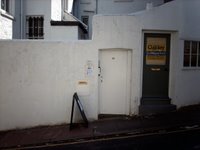Partial Transcript of Forum For Um Painting, as heard by D. Norton on 7th and 11th of February 2012
Tuesday 7th February
Josh
Bringing things together that aren’t normally together, stars in the day ….
Record covers, a point of departure
The texture of Josh’s work – feeling of vinyl in abstract painting next to a painting of record cover.
Experimental sculptural paint
Pouring household paint, found objects – colour of paint, album cover photo.
Modernism – a Klee wall, the pantone fence – should it be a stronger Modernist element and in household paint? No no
Painting carrying so many other narratives – the paving slabs referring to some other painting (a Davenport?)
The gap in between
The mixture of paintings deny some sort of hierarchy between them all.
Should the paintings be larger? Modesty. The sense that something is more important than making an enjoyable painting.
Max
When you paint an object it becomes more than it is. Varnish through painting understand the objects, an experience of touch through sight
Go to the town hall in Hove – all wood interior. Visual diary.
Magritte painting – kissing people – the lovers - not worried about skill. Didn’t want to name Magritte as once you have done so it is there. Skin coloured paint.
The square. Not landscape, it’s not a scene. The language of the painting? Disarm.
Get rid of the light and have spaces in front and behind.
The space where the gaze loses itself.
Having an idea, then paint it, consider moving material across the canvas.
Rudimentary, no artifice
Ways of painting wood.
Should just do the nonchalance
Post audio-visual
Sitting on the floor
Knowledge of 3 dimensions and filmic language
‘scene painting’
Andrzej Jackowski
The Apparatus of Painting
Giuseppe
Doing watercolour seriously, from mobile phone photos. Half done – normally posted, damaged written on
Social capital – showing off for a small group of family and friends
An evening class for old ladies in Rottingdean.
It impresses old ladies. A hobbyist medium.
The sending is probably the best bit of it. I go to Cardiff and I buy a postcard of Castle …. (Wales)
Doing it better (than commercial cards) and then passing it back in
How do they sit against the ‘official’ images?
A girl took two months to reply, he was waiting.
If you received it you would put it on your mantelpiece and give it more time than a painting in a show in Tate.
Difference between digital and analogue art
Saturday 11th February 2012
Josh
Josh’s past allowed to surface in his work. A feel for the magazine paper, glossy. The gloss paint. The seductive sheen.
Daniella
Thinking about becoming something else - paintings looking like I did them. Trying not to ‘do me’. What about when my brother asked when he would become a girl… transmuting identities, memories of people and how they forge your own self, the smell of ginger biscuits, warmth, the piano.
Mike S
Why these? What do you get out of a situation like this?
Redemption narratives, the healed and the unhealed, cheerleader and the thing.
How important is disengagement? The context is important, obfuscation strategy
The potential for narratives, and the incomplete narrative, are you for the internal workings of the painting? Yes they are
Greenberg – ‘painting is an end in itself’
Is the style a meta-narrative?
Harriman – cartoons, Picasso admirer of his, no punch lines
The Crystal World, JG Ballard
Pop/low/high …culture
A process of comparing the higher logic of painting to the reality
Creating reality, the metaphysics of it
The last utopia of modernism – is this how to do it? That is reductive
Do you have any strategies on colour? Points to the thing being fabricated
What happens when you look at a painting? They have to be believed in.
Pavilion of the Sun – Victor Pasmore















































